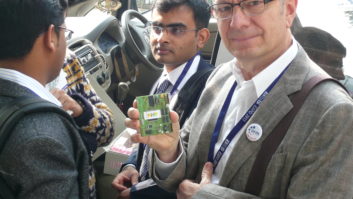IBiquity would like to see its technology in a wireless mobile device in 2013, defining mobile as either a phone or tablet.
That depends, of course, on the outcome of talks between the radio and wireless industries about embedding or activating FM chips in those devices. Several sources told Radio World they couldn’t get into specifics, other than to say those talks are “active and intense.”
Meanwhile HD Radio technology in the car continues to evolve as automakers move to large entertainment screens as the “radio” portion of an infotainment center.
There’s talk of the federal government possibly mandating rear-view back-up cameras in vehicles for safety reasons, says iBiquity Digital President/CEO Bob Struble. “If they mandate that you can expect to see a screen in every single car.”
What does that mean for stations?
“The fact is, if you’re an analog station, broadcasting and being displayed on a screen like that, it’s largely going to be a blank screen. In most instances it will just be your frequency displayed,” said Struble, who added, “whereas we know what the digital display will look like.”
Consumers can look at Chevys, Fords, BMWs or Volkswagens now to see their stations displayed using HD Radio technology. Mentioning the advanced data capabilities of the technology like Artist Experience, in which the audio is synched with visual elements, Struble says those receiver displays show album covers and visuals for multicast channels.
With digital transmission, “that screen gets filled up,” he said. “We think it’s a competitive necessity for broadcasters to have a 21st century look” for their display.
“If someone is listening to SiriusXM, or Pandora, iHeartRadio or to their iPod in the car, they’re going to be seeing that stuff, so radio needs to kind of catch up.”
Struble believes the radio industry is beginning to realize that as radio folks buy new cars with big, new infotainment screens in the dash.
Some 29 automakers include HD Radio receivers in their vehicles, though not all of them have made their intentions public.
Struble says that’s because car cycles are long and some manufacturers prefer to wait until the product is closer to being available to announce features.











